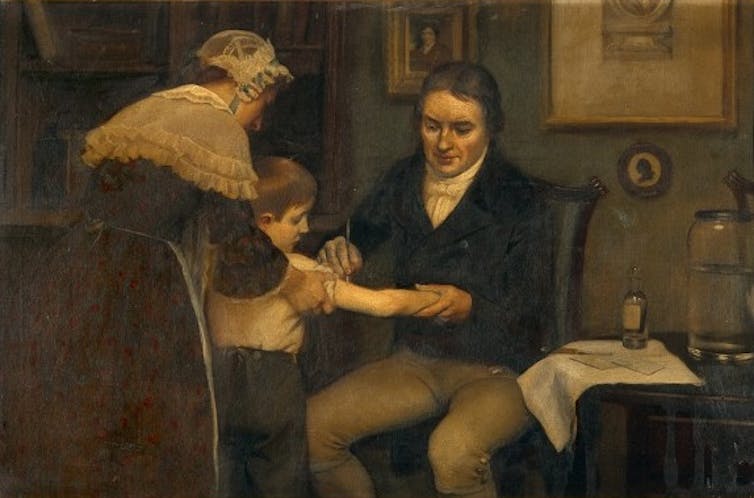SARS-CoV-2, the virus that causes COVID-19, is here to stay for the summer. What happens next, though, is unclear. One possibility is a major second wave in the autumn or winter. This scenario would reflect the behaviour of the 2009 H1N1 “swine flu” pandemic and its deadlier predecessor in 1918, the so-called Spanish flu.
If SARS-CoV-2 resurges in the winter, it will be one in a crowded field of wintertime respiratory viruses, including influenza, rhinovirus, respiratory syncytial virus (RSV), and four other coronavirus strains that normally cause common cold-like symptoms.
What effect might these other viruses have on the spread of SARS-CoV-2? Will they coexist harmoniously, or could they push SARS-CoV-2 out of circulation? We can’t yet be certain, but we can look to the historical interactions between these and other well-known viruses to outline the possibilities.
Cross protection
Near the end of the 18th century, the English physician Edward Jenner observed that milkmaids rarely fell victim to the deadly and debilitating smallpox. He correctly guessed that exposure to cowpox – a related virus that causes much milder illness – protected them.
Jenner’s breakthrough is normally associated with the invention of the first vaccine, but his discovery illustrated an even more fundamental concept: pathogens exist in relation to one another, and sometimes they can inhibit one another’s ability to spread.

Edward Jenner performing his first vaccination on James Phipps. Ernest Board/Wikimedia Commons
The cross protection that cowpox offers against smallpox is a result of the two virus’s structural similarity. When a person becomes infected with cowpox, the immune system mounts a fast, broad-spectrum response followed by a slower, more targeted response that is tailored to the virus.
After clearing the infection, the body keeps a biological template of the virus’s shape so that it can quickly recognise and respond to any future exposures. The structure of smallpox is so similar to the structure of cowpox that the body is able to fight off a smallpox infection, even if it has only been exposed previously to its milder cousin.
Cross protection explains the effectiveness of flu vaccines. Each year, scientists guess which influenza strains will be the most common in the coming season. The guess is invariably “wrong”, but the vaccine is close enough to prevent many infections.
Cross protection also explains why elderly people fared unexpectedly well during the 2009 flu pandemic: H1N1 flu strains also circulated during the first half of the 20th century, and anyone who was exposed to them retained the biological memory for decades.
Cross protection also regulates the boom-bust cycle of seasonal coronavirus transmission. The four mild coronaviruses are divided into two genetically related pairs, the alphas and the betas, which cause large outbreaks in alternating years. Each strain inhibits the spread of its closest relative, leading to a consistent two-year cycle. SARS-CoV-2 is a beta-coronavirus, meaning that it might have to compete with two close relatives during an autumn or winter wave.
A recent study showed that SARS-CoV-2 can be recognised by the immune systems of people previously infected with one of the milder alpha- or beta-coronaviruses. This does not guarantee cross protection, but it is one of the necessary conditions.
Sometimes even unrelated viruses induce cross protection. In 2009, the H1N1 flu pandemic delayed the peak of the RSV season by a few weeks. Similar shifts in peak outbreak timing have been documented for a variety of respiratory illnesses. This probably has to do with the faster, broader part of the immune response. When the immune system is already in high gear, it is able to fight off infection from other possible intruders.
Exacerbating harm
Cross protection is only half of the story. Viruses can also exacerbate the harm caused by one another. For example, HIV and measles directly attack the immune system, weakening the body’s defences and leaving a person vulnerable to other pathogens.
But there is also another, stranger pathway. Sometimes a previous infection with one viral strain can actively help a closely related strain to invade. Dengue virus is the most famous example. A person’s first infection with dengue is likely to be mild, but the second can be life-threatening. The dengue strain that causes the second infection can hitch a ride on the antibodies that were produced to clear the first, helping the second strain to enter cells and cause a more severe infection.
Similar processes could be in play for SARS-CoV-2. If so, a previous infection with SARS-CoV-2 or another coronavirus could make an infection more severe, not less.
Looking ahead
It’s too soon to say for sure what will happen in the coming months, but important evidence should start coming in soon. The earliest information about viral interactions will come from the southern hemisphere, which is just entering its peak respiratory illness season.
Second, various studies are underway, including one in Seattle and one in New York City to identify the full range of respiratory viruses in densely populated settings. Combining the findings from these studies with SARS-CoV-2 surveillance will help us to get an early glimpse into interactions between respiratory viruses.
Still, models and historical experience with flu pandemics suggest that SARS-CoV-2 is probably here to stay for the foreseeable future, even if some cross protection is in play. The field might seem crowded for respiratory viruses, but there’s ample room for one more.



 Why do young people have such poor mental health? A psychologist explains
Why do young people have such poor mental health? A psychologist explains  Good for your health and the environment: why we should be eating oily fish
Good for your health and the environment: why we should be eating oily fish  What your sad desk sandwich says about your working habits
What your sad desk sandwich says about your working habits  What if flat feet were…normal? Debunking a myth about injuries
What if flat feet were…normal? Debunking a myth about injuries  Honey is said to help with hay fever symptoms – here’s what the research says about this claim
Honey is said to help with hay fever symptoms – here’s what the research says about this claim  Snakebites: we thought we’d created a winning new antivenom but then it flopped. Why that turned out to be a good thing
Snakebites: we thought we’d created a winning new antivenom but then it flopped. Why that turned out to be a good thing  Elon Musk says ketamine can get you out of a ‘negative frame of mind’. What does the research say?
Elon Musk says ketamine can get you out of a ‘negative frame of mind’. What does the research say?  Online wellness content: 3 ways to tell evidence-based health information from pseudoscience
Online wellness content: 3 ways to tell evidence-based health information from pseudoscience  An apple cider vinegar drink a day? New study shows it might help weight loss
An apple cider vinegar drink a day? New study shows it might help weight loss  Traditional Japanese diet associated with less brain shrinkage in women compared to western diet, says research
Traditional Japanese diet associated with less brain shrinkage in women compared to western diet, says research  Type 2 diabetes is not one-size-fits-all: Subtypes affect complications and treatment options
Type 2 diabetes is not one-size-fits-all: Subtypes affect complications and treatment options  Study links microplastics with human health problems – but there’s still a lot we don’t know
Study links microplastics with human health problems – but there’s still a lot we don’t know  Proteins in milk and blood could one day let doctors detect breast cancer earlier – and save lives
Proteins in milk and blood could one day let doctors detect breast cancer earlier – and save lives  Gut microbiome: meet Roseburia intestinalis — the energy-producing bacterium that helps us fight against disease
Gut microbiome: meet Roseburia intestinalis — the energy-producing bacterium that helps us fight against disease  Child health is in crisis in the UK – here’s what needs to change
Child health is in crisis in the UK – here’s what needs to change  Tapeworm larvae found in man’s brain – how did they get there?
Tapeworm larvae found in man’s brain – how did they get there?  Personalized cancer treatments based on testing drugs quickly leads to faster treatment, better outcomes
Personalized cancer treatments based on testing drugs quickly leads to faster treatment, better outcomes 































